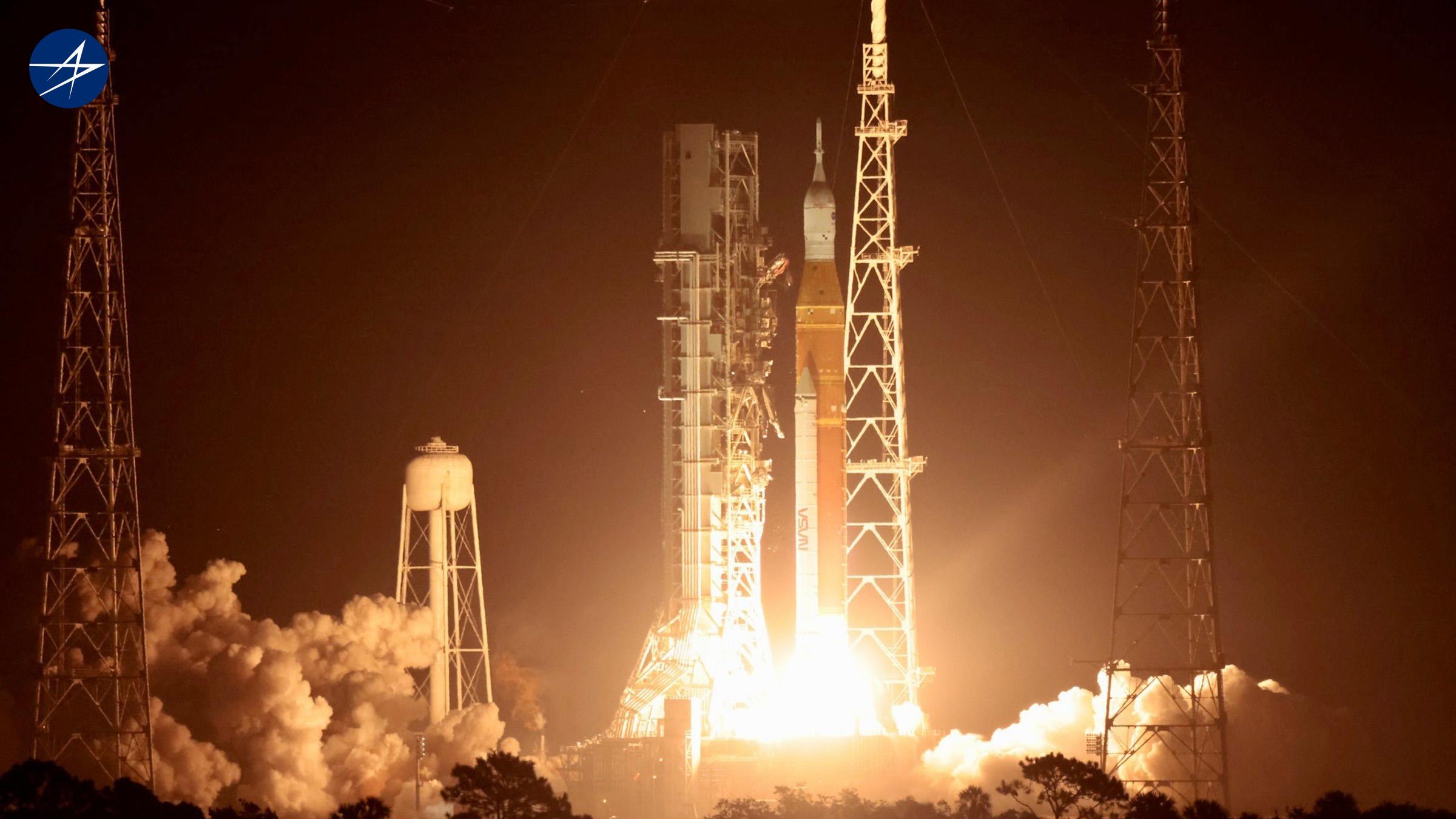
CAPE CANAVERAL—The most powerful rocket NASA has ever built lifted off from the Kennedy Space Center on Nov. 16, ending years of delays in the debut of the Artemis Moon program, which is intended to expand human presence beyond low Earth orbit.
Propelled by a pair of solid-rocket boosters and four Aerojet Rocketdyne RS-25 liquid-fueled main engines, the Space Launch System (SLS) rocket soared off of Kennedy Space Center’s Launch Complex 36B with a blinding light and thundering roar at 1:47 a.m. EST.
Two min. 11 sec. later, the five-segment boosters, manufactured by Northrop Grumman, were jettisoned, leaving the RS-25 engines firing for another 6 min. to deliver the rocket’s upper stage and attached Orion capsule into a preliminary orbit 104 mi. above Earth.
The rest of the boost was up to the Interim Cryogenic Propulsion Stage (ICPS), powered by a single Aerojet Rocketdyne RL10 engine. ICPS first conducted a 22-sec. burn at 2:41 a.m. to raise Orion into an initial stable orbit.
The spacecraft, built by Lockheed Martin, then deployed its solar arrays, setting the stage for a second ICPS burn that accelerated Orion to 25,600 mph—fast enough to escape the clutch of Earth’s gravity and reach the Moon. The 18-min. trans-lunar injection burn, which began at 3:14 a.m., was the longest ever conducted by an RL10, which has been operating for 60 years.
After separating from Orion, the ICPS was expected to release 10 cubesats flying as secondary payloads. They include three lunar orbiters, a lunar lander, three radiation probes, an asteroid scout and technology demonstrations.
Packing 8.8-million lb. of thrust, the SLS is a two-stage expendable rocket that draws heavily from the predecessor space shuttle program. In its initial configuration, the SLS is designed to put 60,000 lb. on a trajectory to reach the Moon. Its lift capacity increases to 84,000 lb. to the Moon with the four-engine Exploration Upper Stage, currently in development. Boeing is the prime contractor for SLS.
NASA tried three times in August and September to launch the SLS, which carries an uncrewed Orion spacecraft for a shakedown cruise in a distant retrograde lunar orbit. Two launch attempts were stymied by hydrogen leaks and other technical issues, while the last try was thwarted by the Category 4 Hurricane Ian.
The 322-ft.-tall SLS and Orion were returned to the launchpad on Nov 4, only to face another hurricane. The Category 1 Hurricane Nicole, which hit the Central Florida east coast on Nov. 10, peeled away some of the silicon-based insulation near the top of the Orion capsule but NASA determined the damage did not pose a flight risk.
In an attempt to preclude hydrogen leaks that bedeviled previous SLS launch attempts and tanking tests, NASA developed what it called a “kinder, gentler approach” to fueling by reducing the pressure in the liquid hydrogen storage sphere to slow propellant flow.
Though tanking took an hour longer than previous attempts, the procedure worked flawlessly for filling the core stage tanks with 733,000 gal. of cryogenic liquid oxygen and liquid hydrogen, which fed the RS-25s during their 8 min. 15 sec. of flight.
The launch team, headed by Charlie Blackwell-Thompson, then turned its attention to filling the the ICPS tanks with 20,000 gal. of the same propellants.
Preparations continued smoothly until about 9:30 p.m. when sensors detected a small leak in a hydrogen replenish valve in the base of the mobile launcher. Two technicians and a safety officer headed out to the launchpad to check connections and found loose packing nuts, which they tightened in an attempt to stem the leak. The repair was successful, and NASA resumed replenishing the core stage with liquid hydrogen, which naturally boils off in the warm Florida air.
As that issue was put to rest, safety officers with the U.S. Space Force’s Eastern Range reported a problem obtaining data from a radar tracking system due to a faulty ethernet switch. Replacing the switch took about 70 min., clearing the way for the countdown to resume, leading to liftoff 43 min. into the 2-hr. launch window.
“There’s definitely relief that we’re underway,” Artemis I Mission Manager Mike Sarafin said at a post-launch news conference which began at 5 a.m.
SLS’s successful debut sets the stage for a 25-day flight test of Orion, manufactured by Lockheed Martin. The spacecraft is designed to carry a crew of four into deep space for missions lasting up to 21 days.
NASA is particularly interested in the performance of the spacecraft’s heat shield during its 25,000 mph return through Earth’s atmosphere, expected on Dec. 11. Splashdown is expected in the Pacific Ocean off the coast of San Diego.
NASA plans to follow the uncrewed Artemis I with a crewed flight test on Artemis II in about two years.
Beginning with Artemis III, NASA plans to land astronauts on the south pole of the Moon, kicking off a U.S.-led effort to open cislunar space for human exploration, research and commercial activity. Just as the space shuttle and International Space Station programs were the basis for moving beyond Earth orbit, NASA and its partners intend to parlay the Artemis program into crewed missions to Mars.
“It took a long time to get here... and we have a long way to go,” said NASA Administrator Bill Nelson, noting that it has been 50 years since astronauts last landed on the Moon.
SLS Program Manager John Honeycutt added, “We’ve laid the foundation for the Artemis program and many generations to come.”




Comments